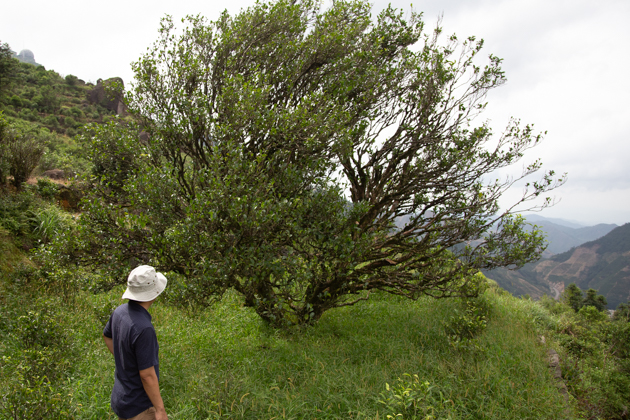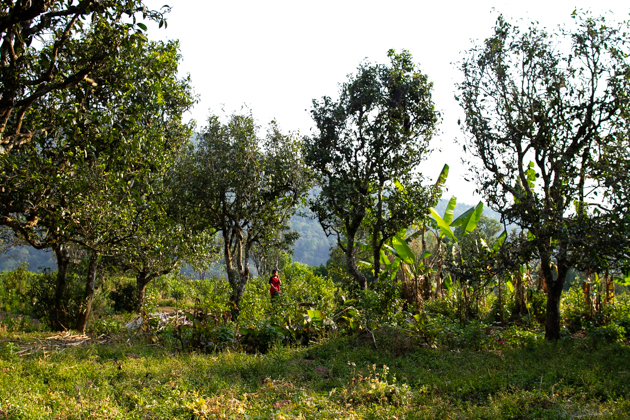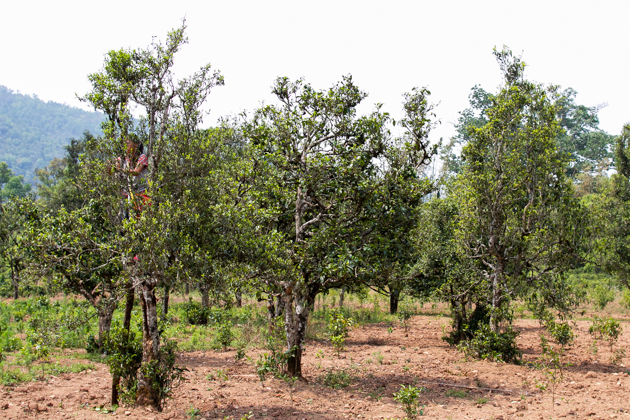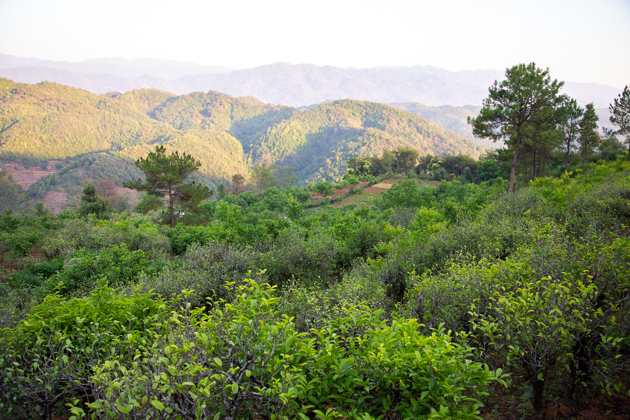- HOME >
- Tea Column
Hidden Costs of High Valuations of Old Tea Trees
- [2023.04.03] Posted By Akira Hojo

Over the past decade, tea enthusiasts in China have been captivated by teas harvested from Ancient Tea trees, particularly those from Yunnan province, Phoenix Dan Cong Oolong Tea and Wuyi Rock Tea. However, as Ancient Tea trees are rare, the prices of teas harvested from them have skyrocketed. As a result, some farmers who possess Ancient Tea trees tend to overprotect them, which can lead to unintended negative consequences.
Amateur enthusiasts who admire Ancient Tea trees
Factors such as altitude, absence of fertilizers, age of tea trees, and clay soil are crucial in improving tea quality. However, the age of tea trees is often overemphasized. In reality, each factor plays a significant role in tea quality, and it is important not to solely focus on the Ancient Tea trees.

Tea gardens lined with huge tea trees

Nonetheless, Ancient Tea trees possess a visible and remarkable presence, making them alluring to amateur tea enthusiasts. Teas harvested from Ancient Tea trees have a rich aftertaste, strong aroma, depth, and a lingering sweetness known as “Hui Gan” in Chinese, making them highly valued for their quality.
Why Tea from Old Trees in Remote Areas is Becoming More Expensive
In the remote villages of Yunnan province, one can frequently encounter ancient tea trees. However, these prized trees are typically not traded at premium prices within these local communities. The dynamics change, however, when infrastructure projects such as highways and airports are constructed near these villages, attracting tea buyers and tea enthusiasts on the lookout for authentic tea experiences. In the absence of knowledge about the local market, these tourists often end up paying inflated prices for the tea they purchase. Furthermore, local wholesalers contribute to the speculation by artificially driving up the price of tea. Once news spreads that tea from a particular village commands a high price, the market value can experience a sudden and significant surge. As a consequence, prices skyrocket within just a few years. In recent times, it has become increasingly common for tea sourced from old trees to fetch prices several times higher than that of other teas in the market.
Since tea farmers only have a limited number of trees, increasing the yield from a single old tree can increase their income. Moreover, for highly-priced old trees, farmers may want to increase the yield even more. Therefore, in villages where prices are rising, there’s often an increase in the use of fertilizers. This can cause the trees to grow faster, resulting in a higher yield and more income for the farmers.
How Fertilizer Can Cause Sudden Death in Tea Trees
In remote mountainous areas of Yunnan province, tea trees are often left to grow naturally, with no artificial inputs like fertilizers. Some tea gardens that produce HOJO’s white tea, pu-erh tea, and Yunnan black tea are cultivated in this way, where the tea trees are descendants of those planted by ancestors and left to grow undisturbed. Many of these trees are over 100 years old and have thrived in their natural environment.

However, applying fertilizer can cause a sudden increase in nitrogen levels in the tea trees, which can in turn lead to an increase in harmful microorganisms, mites, and insects. Microbes and insects are attracted to nitrogen and thrive in environments rich in this nutrient, so applying fertilizer can sometimes cause the tea trees to die suddenly due to infestations.
Sudden death of old tea trees is not unique to Yunnan province and has also been observed in tea plantations in other regions, such as the Wudong Mountain in the Phoenix tea-growing region.
The essence of traditional farming in Yunnan province
The reason why tea farmers in Yunnan province adhered to traditional cultivation methods was actually to maintain the health of the tea. By growing tea in a natural state, tea trees naturally absorb the necessary nutrients and maintain a healthy state. In addition, the use of fertilizer-free farming methods reduces the nitrogen concentration in tea trees, which eliminates the risk of pathogenic infection and pest damage, while also affecting the taste of the tea. Since the components contained in the tea leaves change, naturally cultivated tea has a richer and deeper taste without any chemical taste or aroma.
Related Articles
How to get the latest update on HOJO?
1. Follow Twitter, 2. Click "Like" on Facebook, and 3. Subscribe in newsletter. You can have the latest tea news from HOJO.
 Subscribe the Newsletter to enjoy the privileges
Subscribe the Newsletter to enjoy the privileges- You may receive a free sample upon purchase, or you may have the priority to purchase special products. So please remember to subscribe our newsletter as well as the social network.
- Myanmar White Tea Bud 2013 from Guo Gan, Myanmar
- We have released a raw Pu-erh tea, 緬甸白芽茶 2013 (Myanmar White Tea Bud 2013), produced by ethnic minorities in t …
- Yong De Wild White Tea 2025 Loose Leaf Limited Release
- We have released Yong De Wild White Tea Loose 2025. For the 2025 harvest, only the loose-leaf type was …
NEW ARTICLES
 Myanmar White Tea Bud 2013 from Guo Gan, Myanmar
Myanmar White Tea Bud 2013 from Guo Gan, Myanmar- We have released a raw Pu-erh tea, 緬甸白芽茶 2013 (Myanmar White Tea Bud 2013), produced by ethnic minorities in t …
 Yong De Wild White Tea 2025 Loose Leaf Limited Release
Yong De Wild White Tea 2025 Loose Leaf Limited Release- We have released Yong De Wild White Tea Loose 2025. For the 2025 harvest, only the loose-leaf type was …
 Experience the True Freshness of Raw Pu-erh : Tang Jia 2025 Loose Leaf Release
Experience the True Freshness of Raw Pu-erh : Tang Jia 2025 Loose Leaf Release- We have released Tang Jia Raw Pu-erh Tea 唐家古樹生茶 2025 Loose Leaf. Among HOJO’s raw pu-erh teas, Tang Jia Raw Pu …
 Yunnan Chun Jian Green Tea from High Mountain Gardens
Yunnan Chun Jian Green Tea from High Mountain Gardens- Yunnan Chun Jian Green Tea is now available. This tea is made from naturally grown leaves harvested from high …
 Limited Loose Leaf Release of 2025 Da Xue Shan Wild Raw Pu-erh Tea
Limited Loose Leaf Release of 2025 Da Xue Shan Wild Raw Pu-erh Tea- We have released the 2025 loose-leaf version of Da Xue Shan Wild Raw Pu-erh Tea. This tea comes from wild tea …
 Discover a New Way to Enjoy Tea: Cooking Rice with Tea
Discover a New Way to Enjoy Tea: Cooking Rice with Tea- Cooking rice with tea is a simple idea, but it brings surprisingly satisfying results. The tea’s flavour seeps …
 2025 Da Xue Shan Wild White Tea Now Available from Yunnan
2025 Da Xue Shan Wild White Tea Now Available from Yunnan- The 2025 harvest of Da Xue Shan Wild White Tea is now available. Crafted from truly wild Camellia taliensis tr …
 Fresh 2025 Yunnan White Tea – Select Your Favourite Lot Before Blending
Fresh 2025 Yunnan White Tea – Select Your Favourite Lot Before Blending- Freshly crafted in Yunnan and just arrived in KL, our new 2025 white tea is now available at our Gardens Mall …
 2024 Dong Shan Raw Pu-erh Tea – Crafted with the Producer for Desired Quality
2024 Dong Shan Raw Pu-erh Tea – Crafted with the Producer for Desired Quality- We have released the 2024 cake of Dong Shan Raw Pu-erh Tea. Earlier, we offered the loose-leaf version from th …
 Development of Firewood Roasted Hojicha Using Naturally Grown Tea from Yunnan
Development of Firewood Roasted Hojicha Using Naturally Grown Tea from Yunnan- We are currently staying in Yunnan Province for tea production. As the season nears its end, tea trees with pa …
Category
- New Arrival at HOJO Online Shop
- Featured Articles
- Newsletter
- Types of Tea
- Origin of Tea
- Teapot and Tea Equipment
-
Tea Column
- How to enjoy tea
- Tea Processing
- How to choose quality tea
- Tea constituents and functional effect
- Safety of Tea
- Foods
- Tea Business Operation
- Hobby and Outdoor Activity
- Ranking of Tea
- Video
- FAQ
- Media Release
Profile

- AKIRA HOJO
- I invite you to experience my tea selections.I was born in Nagano, Japan. In university, I studied agricultural chemistry, and I have the master degree in food science. I worked in Japanese food industry for 10 years. I involved in R&D, QC and QA. As a factory manager, I implemented ISO9000 series and managed the factory.
- The Art of Tea Magazine
- We posted the article on “The Art of Tea Magazine No.9, the magazine is published in Taiwan. We featured …
- New Straits Times
- The Malaysian National Newspaper, New Straits Times featured HOJO Tea on 17-Oct-2007.
Shop Info

Address:Lot No. T-215, 3rd Floor, The Gardens Mall, Mid Valley City, Lingkaran Syed Putra, 59200 Kuala Lumpur
Tel: +603-2287-4537
Business Hour: 10am to 10pm














